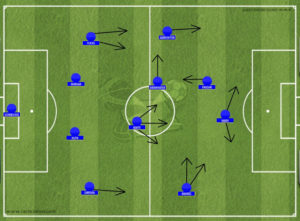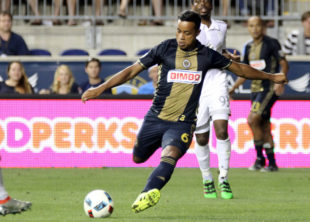Photo: Paul Rudderow
We close our offseason look at Philadelphia Union’s potential tactical setups by examining systems with four backs and two strikers. Again, the question is whether the Union can continue to meet their same strategic goals with different tactical systems than the 4-2-3-1 utilized last season. For a closer examination of how these shapes differ in the spaces they allow opponents, see this old PSP post (though note that it refers to the Union’s system as a 4-1-2-2-1, which is just as accurate as the 4-2-3-1, and highlights the frustrations involved in using these numerical descriptors).
The enigmatic and frustrating 4-4-2
The beauty of the 4-4-2 — and the reason it was the most common shape employed for years — is its flexibility. While 4-3-3 systems that morph into 4-2-3-1s and 4-3-2-1s are everywhere now, a hidden driver in their ubiquity is the sports science that means most teams have players making Cafu-like runs for 90 minutes up the wings. In a sense, modern systems are a product of fitter players’ ability to occupy multiple positions in the old 4-4-2 framework. With fullbacks bombing up the line, ostensible wingers/wide mids can spend far more time tucked into the areas formerly reserved for trequartistas or dart up top to support the lone striker.

Leicester City’s 2015-16 shape (from Outsideoftheboot.com)
But there is still value in the 4-4-2. First, it is a wonderful shape in which to defend and counterattack (I see you, Leicester City!). The “two banks of four” minimizes the useful space an attacking team can use to enter the box, and it provides multiple potential outlets through which a counterattack can be quickly linked. Second, the 4-4-2 places two strikers high up the pitch, allowing a team to pressure opposition center backs and force long, loose passes. Those two strikers can also link and attack with more speed than teams who rely on a single striker with midfield support. Third, strikers are, or should be, better finishers than midfielders. The decline of two striker systems coincided with the rise of inverted wingers because teams realized they could add bodies to the center of the pitch without sacrificing much in terms of attacking threat. By replacing less mobile, but quite lethal, big strikers with jinky, dynamic, but less efficient inverted wingers has been an interesting tactical push-and-pull, with the world’s best international teams still unsure whether they need a central striker or not (e.g., Spain, Germany).
Fourth, and the original reason 4-4-2 became the default shape for an extended period of time, the midfield shape can quickly morph to fit personnel. Don’t have fullbacks that get forward? Play a flat midfield to get bodies wide. Need to battle for the middle? Play a tight diamond. Want to counterattack like you can in FIFA? Bust out the Y-midfield that keeps two down the gut and pushes the wingers on diagonal wide runs on the break.
Beauty in simplicity
The 4-4-2 shape, because it can mould itself so amenably to a team’s specific goals, can simplify the roles and responsibilities of the players in it. The key is that a 4-4-2 can allow players simple cues for how to move defensively while maintaining good structure. Look at two banks of four moving side to side, with the player closest to the ball stepping forward to force a decision while teammates keep standard distances between each other both vertically and horizontally.
Additionally, a 4-4-2 with a single holding midfielder allows that player to act as a midfield sweeper. This means he reacts to the ball and the shape of players in front of him, but has no partner who must read and react to him (this is a gross simplification of the role, but the point stands).
Overall, the major benefit of the 4-4-2 can be summed up this way: It can simplify decision-making for most players on the pitch. However, that simplicity comes at a cost. Two-striker systems can be pinned back by three-man midfields that control the center and overwhelm deeper mids.
A quick aside: Adding a second striker or a third defender late in a match is not the same thing as playing a two-striker or three-back system. Those late substitutions and shape changes are made with very specific goals in mind, and they knowingly minimize other legitimate goals that fall down the pecking order as a match winds down. They are short-term risk minimization or return maximization substitutions, not broader tactical plans.
Union success?
In the past, the Union have operated with two deep holding midfielders forming the bottom of an “empty bucket” midfield shape. One striker will drop a bit deeper defensively, with instructions to force play wide, providing nominal strength in the center. Philly struggled with this shape for many reasons, not the least of which was how easily the system became stretched. In the modern game, a stretched defense is a broken defense. With two midfielders strongly prioritizing defense and two others strongly prioritizing attack, space for the opposition to start and develop counterattacks is easy to find. While the holding mids may keep those counters from producing immediate results, the opposing team can enter the final third and camp out with alarming frequency if the more advanced mids are anything less than hyper-diligent getting back. The empty bucket shape is also useful because the holding midfielders do not need to be dynamic two-way players (though, of course, it helps).
The Union should not (and likely will not) return to an empty bucket. It is far too passive of a formation for Earnie Stewart, and it would mean adopting a sit-and-absorb mindset after a year of nominal aggression. That said, Philly’s current options in the middle are more amenable to an empty bucket than any other version of the 4-4-2.
The Union have no pure creative force to sit on top of a diamond (we can argue about Ilsinho, but the numbers don’t tell a creative story), nor do they have a (healthy) defensive mid who is mobile, intelligent, and a strong passer. Additionally, Philly is short on players who are comfortable as narrow box-to-box players. Chris Pontius and Ilsinho would rather be wider so they can operate in space, and Roland Alberg is far too valuable around the box to shuttle up and down the pitch.
Will we see it in Philly?
Put admiringly, the 4-4-2 is a cockroach of a system. The defensive benefits it offers around the edge of the box weigh heavily, and when a striker pair works well together, they can offer quick, effective outlets that let a team relieve pressure without feeling like the ball is going to come right back down their throat. Perhaps a good test for whether a team should use a second striker is this: Is the second striker simply a much better player than anybody that team could add to the midfield? If so, go for it. This is something like the calculation Watford made for the 2015-16 season. (Note that a different question one could ask is: Is our striker the best healthy distributor on our roster right now? That is what Greg Vanney answered affirmatively with Jay Chapman and Giovinco injured and Jozy Altidore healthy in 2016).
Glancing at the current roster, there may certainly be times in 2017 when new signing Jay Simpson is the best creative hub on the pitch. He reportedly has good feet and connects play well. During those times, the Union would be justified in considering a two-striker set.
The rest of the time? Expect a 4-2-3-1. And it’ll be the right decision, too.


We will play with one lone striker. End of story. If we didn’t in our death spiral of last season, why would we now?
Three on the roster, including a healthier Davies?
In a two striker set I could see CJ, Simpson, Davies, Herbers, Alberg, and even Pontius fitting in as part of the striker set.
I’d be more worried about the midfield. Bedoya and Edu (or Creavalle/Carroll in a holding role) would be fine, but who is playing those wider positions. Seems like our D would get run over to me.
Pontius is a solid two-way player on the left. The right would be a little troublesome since Ilsinho is not the best defender (though to his credit he did get better later in the season) and Herbers, while certainly willing to do the dirty work, is new to the position.
.
My biggest worries are up the center as I commented below.
Fair enough. I do agree another midfielder is our biggest need (and has been all off-season).
I’ll bite. Davies, Simpson, and who’s your third creative distributor playing striker? Herbers?
The biggest worry I would have if the Union try a version of the 4-4-2 is the give-and-take at both the center midfield and striker positions. For example, in the traditional flat 4-4-2 would both CMs get caught up-field on the counter? Would they both hang and not provide support to the attackers? Same with the strikers – would they make the same runs and get in each others way? Would both stay high and not connect in the build up play? Would they both drop in the build up and allow the defense to condense the field of play?
.
It takes a good amount of time playing together to build that understanding with the person next to you and would likely take half the season to just begin to get comfortable in the system.
The conventional wisdom on why Leicster has struggled so much is that they can’t win midfield battles against teams with three central midfielders against their two. The end up overmatched. And with Kante plying his trade for Chelsea, it suggests having a fantastic, defensive midfielder who can pass (controlling?) is key. You also need very good center backs. Given last season’s common lineup for the Union, which saw two defensive midfielders (aka C+C Music Factory, a la the artist formerly known as El Pachy), it’s hard to imagine Philly going there, unless Curtin is satisfied that his two center mids are strong enough on opening day (Bedoya and Edu?). I’d love to see the formation though, because I think a pair of attacking goal scorers could really punch a hole in this league. I love the idea of a Simpson/Alberg pairing. Sapong might really benefit from pairing up with someone else, too.
I also think a diamond 4-4-2 could be decent with a great #6 signing, have your 2 wide mid as Pontius and Bedoya and Alberg as the 10. The D could get over-run though.
Philly traded up to the third pick in the 2nd round, it was announced as for the 20th pick in the 2nd round and $50 K of 2018 GAM.
The took Nicholas Epps from U of South Florida.
With its natural 2nd round pick #33 the Union take right back Aaron Jones from Clemson. By accent and podium comment he is British Isles English.
.
Unless Ray Gaddis is going somewhere, and assuming Jones is not traded, Mark McKenzie now has competition at right back on the Steel. Of course I have not jumped to more than five separate conclusions in one sentence there!
Marcus, not Nicholas. My error.